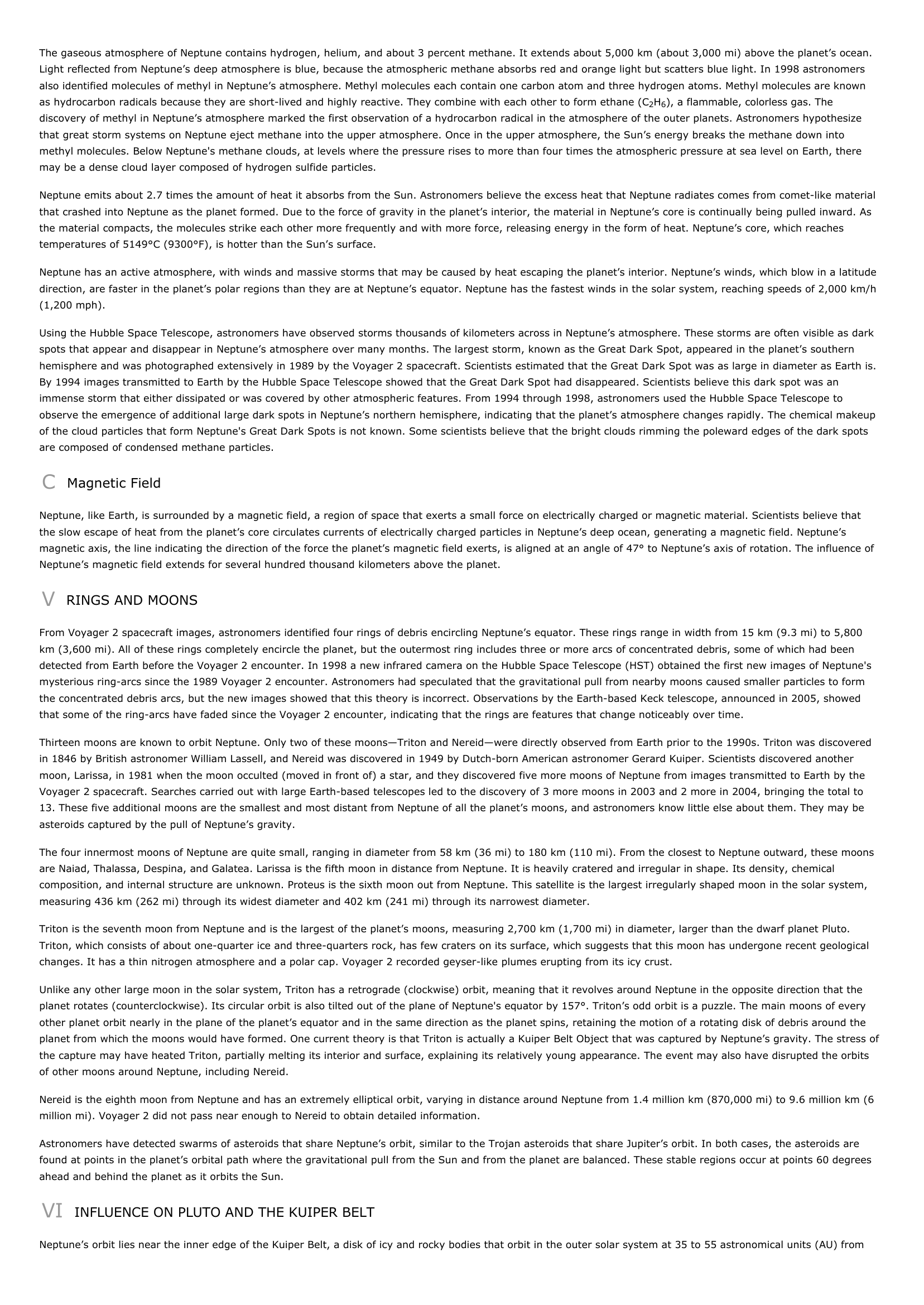Neptune (planet) - astronomy.
Publié le 11/05/2013

Extrait du document


«
The gaseous atmosphere of Neptune contains hydrogen, helium, and about 3 percent methane.
It extends about 5,000 km (about 3,000 mi) above the planet’s ocean.Light reflected from Neptune’s deep atmosphere is blue, because the atmospheric methane absorbs red and orange light but scatters blue light.
In 1998 astronomersalso identified molecules of methyl in Neptune’s atmosphere.
Methyl molecules each contain one carbon atom and three hydrogen atoms.
Methyl molecules are knownas hydrocarbon radicals because they are short-lived and highly reactive.
They combine with each other to form ethane (C 2H6), a flammable, colorless gas.
The discovery of methyl in Neptune’s atmosphere marked the first observation of a hydrocarbon radical in the atmosphere of the outer planets.
Astronomers hypothesizethat great storm systems on Neptune eject methane into the upper atmosphere.
Once in the upper atmosphere, the Sun’s energy breaks the methane down intomethyl molecules.
Below Neptune's methane clouds, at levels where the pressure rises to more than four times the atmospheric pressure at sea level on Earth, theremay be a dense cloud layer composed of hydrogen sulfide particles.
Neptune emits about 2.7 times the amount of heat it absorbs from the Sun.
Astronomers believe the excess heat that Neptune radiates comes from comet-like materialthat crashed into Neptune as the planet formed.
Due to the force of gravity in the planet’s interior, the material in Neptune’s core is continually being pulled inward.
Asthe material compacts, the molecules strike each other more frequently and with more force, releasing energy in the form of heat.
Neptune’s core, which reachestemperatures of 5149°C (9300°F), is hotter than the Sun’s surface.
Neptune has an active atmosphere, with winds and massive storms that may be caused by heat escaping the planet’s interior.
Neptune’s winds, which blow in a latitudedirection, are faster in the planet’s polar regions than they are at Neptune’s equator.
Neptune has the fastest winds in the solar system, reaching speeds of 2,000 km/h(1,200 mph).
Using the Hubble Space Telescope, astronomers have observed storms thousands of kilometers across in Neptune’s atmosphere.
These storms are often visible as darkspots that appear and disappear in Neptune’s atmosphere over many months.
The largest storm, known as the Great Dark Spot, appeared in the planet’s southernhemisphere and was photographed extensively in 1989 by the Voyager 2 spacecraft.
Scientists estimated that the Great Dark Spot was as large in diameter as Earth is.By 1994 images transmitted to Earth by the Hubble Space Telescope showed that the Great Dark Spot had disappeared.
Scientists believe this dark spot was animmense storm that either dissipated or was covered by other atmospheric features.
From 1994 through 1998, astronomers used the Hubble Space Telescope toobserve the emergence of additional large dark spots in Neptune’s northern hemisphere, indicating that the planet’s atmosphere changes rapidly.
The chemical makeupof the cloud particles that form Neptune's Great Dark Spots is not known.
Some scientists believe that the bright clouds rimming the poleward edges of the dark spotsare composed of condensed methane particles.
C Magnetic Field
Neptune, like Earth, is surrounded by a magnetic field, a region of space that exerts a small force on electrically charged or magnetic material.
Scientists believe thatthe slow escape of heat from the planet’s core circulates currents of electrically charged particles in Neptune’s deep ocean, generating a magnetic field.
Neptune’smagnetic axis, the line indicating the direction of the force the planet’s magnetic field exerts, is aligned at an angle of 47° to Neptune’s axis of rotation.
The influence ofNeptune’s magnetic field extends for several hundred thousand kilometers above the planet.
V RINGS AND MOONS
From Voyager 2 spacecraft images, astronomers identified four rings of debris encircling Neptune’s equator.
These rings range in width from 15 km (9.3 mi) to 5,800km (3,600 mi).
All of these rings completely encircle the planet, but the outermost ring includes three or more arcs of concentrated debris, some of which had beendetected from Earth before the Voyager 2 encounter.
In 1998 a new infrared camera on the Hubble Space Telescope (HST) obtained the first new images of Neptune'smysterious ring-arcs since the 1989 Voyager 2 encounter.
Astronomers had speculated that the gravitational pull from nearby moons caused smaller particles to formthe concentrated debris arcs, but the new images showed that this theory is incorrect.
Observations by the Earth-based Keck telescope, announced in 2005, showedthat some of the ring-arcs have faded since the Voyager 2 encounter, indicating that the rings are features that change noticeably over time.
Thirteen moons are known to orbit Neptune.
Only two of these moons—Triton and Nereid—were directly observed from Earth prior to the 1990s.
Triton was discoveredin 1846 by British astronomer William Lassell, and Nereid was discovered in 1949 by Dutch-born American astronomer Gerard Kuiper.
Scientists discovered anothermoon, Larissa, in 1981 when the moon occulted (moved in front of) a star, and they discovered five more moons of Neptune from images transmitted to Earth by theVoyager 2 spacecraft.
Searches carried out with large Earth-based telescopes led to the discovery of 3 more moons in 2003 and 2 more in 2004, bringing the total to13.
These five additional moons are the smallest and most distant from Neptune of all the planet’s moons, and astronomers know little else about them.
They may beasteroids captured by the pull of Neptune’s gravity.
The four innermost moons of Neptune are quite small, ranging in diameter from 58 km (36 mi) to 180 km (110 mi).
From the closest to Neptune outward, these moonsare Naiad, Thalassa, Despina, and Galatea.
Larissa is the fifth moon in distance from Neptune.
It is heavily cratered and irregular in shape.
Its density, chemicalcomposition, and internal structure are unknown.
Proteus is the sixth moon out from Neptune.
This satellite is the largest irregularly shaped moon in the solar system,measuring 436 km (262 mi) through its widest diameter and 402 km (241 mi) through its narrowest diameter.
Triton is the seventh moon from Neptune and is the largest of the planet’s moons, measuring 2,700 km (1,700 mi) in diameter, larger than the dwarf planet Pluto.Triton, which consists of about one-quarter ice and three-quarters rock, has few craters on its surface, which suggests that this moon has undergone recent geologicalchanges.
It has a thin nitrogen atmosphere and a polar cap.
Voyager 2 recorded geyser-like plumes erupting from its icy crust.
Unlike any other large moon in the solar system, Triton has a retrograde (clockwise) orbit, meaning that it revolves around Neptune in the opposite direction that theplanet rotates (counterclockwise).
Its circular orbit is also tilted out of the plane of Neptune's equator by 157°.
Triton’s odd orbit is a puzzle.
The main moons of everyother planet orbit nearly in the plane of the planet’s equator and in the same direction as the planet spins, retaining the motion of a rotating disk of debris around theplanet from which the moons would have formed.
One current theory is that Triton is actually a Kuiper Belt Object that was captured by Neptune’s gravity.
The stress ofthe capture may have heated Triton, partially melting its interior and surface, explaining its relatively young appearance.
The event may also have disrupted the orbitsof other moons around Neptune, including Nereid.
Nereid is the eighth moon from Neptune and has an extremely elliptical orbit, varying in distance around Neptune from 1.4 million km (870,000 mi) to 9.6 million km (6million mi).
Voyager 2 did not pass near enough to Nereid to obtain detailed information.
Astronomers have detected swarms of asteroids that share Neptune’s orbit, similar to the Trojan asteroids that share Jupiter’s orbit.
In both cases, the asteroids arefound at points in the planet’s orbital path where the gravitational pull from the Sun and from the planet are balanced.
These stable regions occur at points 60 degreesahead and behind the planet as it orbits the Sun.
VI INFLUENCE ON PLUTO AND THE KUIPER BELT
Neptune’s orbit lies near the inner edge of the Kuiper Belt, a disk of icy and rocky bodies that orbit in the outer solar system at 35 to 55 astronomical units (AU) from.
»
↓↓↓ APERÇU DU DOCUMENT ↓↓↓
Liens utiles
- Earth (planet) - astronomy.
- Jupiter (planet) - astronomy.
- Mars (planet) - astronomy.
- Mercury (planet) - astronomy.
- Uranus (planet) - astronomy.









